Flying an echo-sounder to the fish school with a drone

A multi-jet drone with an echo-sounder.
Published: 12.07.2018 Updated: 06.08.2021
![]()
Too large catches can influence fish quality, fish welfare and safety on board. Too small catches are usually not profitable to catch in the first place. Catches containing non-target species are also of lower value.
The sonar on board the fishing vessel gives approximate estimates of school size, but it is difficult to get accurate estimates of fish spatial density. Echo-sounder, on the other hand, can provide information of the species, individual fish size and density, but just below the echo sounder. A combination is therefore the solution.
The practical use, however, is not entirely easy. Research scientist Maria Tenningen and her colleagues have tested the newly developed system on board the fishing vessel “Eros”. She is satisfied with the tests, which must be regarded as a proof of concept.
- We got what we wanted, measurements of fish and the acoustic data visualized in real time. The drone that was used had a flight time limited to about 15 minutes and was sensitive to wind and rain. Further development is therefore needed, but the system is interesting for both research and commercial fisheries, she says.

This drone-project is a collaboration between IMR, Birdview and Simrad (Kongsberg Maritime).
